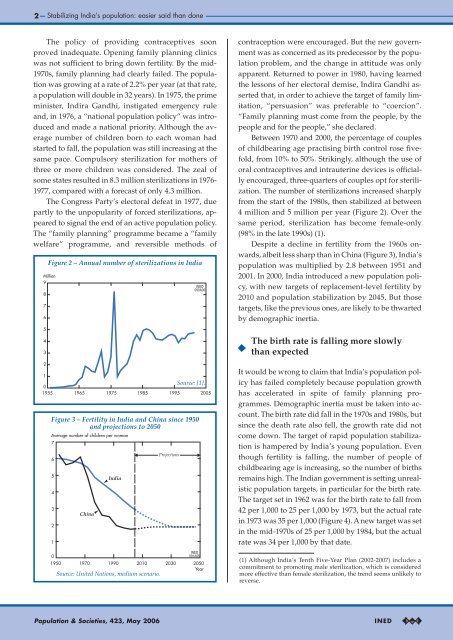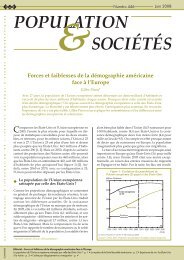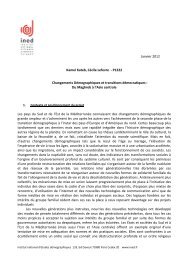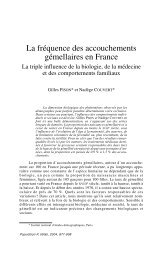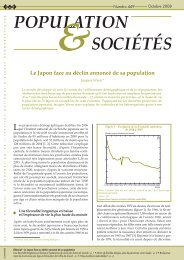Stabilizing India's population: easier said than done - Ined
Stabilizing India's population: easier said than done - Ined
Stabilizing India's population: easier said than done - Ined
- No tags were found...
Create successful ePaper yourself
Turn your PDF publications into a flip-book with our unique Google optimized e-Paper software.
2<strong>Stabilizing</strong> India’s <strong>population</strong>: <strong>easier</strong> <strong>said</strong> <strong>than</strong> <strong>done</strong>The policy of providing contraceptives soonproved inadequate. Opening family planning clinicswas not sufficient to bring down fertility. By the mid-1970s, family planning had clearly failed. The <strong>population</strong>was growing at a rate of 2.2% per year (at that rate,a <strong>population</strong> will double in 32 years). In 1975, the primeminister, Indira Gandhi, instigated emergency ruleand, in 1976, a “national <strong>population</strong> policy” was introducedand made a national priority. Although the averagenumber of children born to each woman hadstarted to fall, the <strong>population</strong> was still increasing at thesame pace. Compulsory sterilization for mothers ofthree or more children was considered. The zeal ofsome states resulted in 8.3 million sterilizations in 1976-1977, compared with a forecast of only 4.3 million.The Congress Party’s electoral defeat in 1977, duepartly to the unpopularity of forced sterilizations, appearedto signal the end of an active <strong>population</strong> policy.The “family planning” programme became a “familywelfare” programme, and reversible methods of8765432Figure 2 – Annual number of sterilizations in IndiaMillion91Source: [1].01955 1965 1975 1985 1995 2005Figure 3 – Fertility in India and China since 1950and projections to 2050Average number of children per woman76543210ChinaIndiaProjectionsINED090A06INED091A061950 1970 1990 2010 2030 2050YearSource: United Nations, medium scenario.contraception were encouraged. But the new governmentwas as concerned as its predecessor by the <strong>population</strong>problem, and the change in attitude was onlyapparent. Returned to power in 1980, having learnedthe lessons of her electoral demise, Indira Gandhi assertedthat, in order to achieve the target of family limitation,“persuasion” was preferable to “coercion”.“Family planning must come from the people, by thepeople and for the people,” she declared.Between 1970 and 2000, the percentage of couplesof childbearing age practising birth control rose fivefold,from 10% to 50%. Strikingly, although the use oforal contraceptives and intrauterine devices is officiallyencouraged, three-quarters of couples opt for sterilization.The number of sterilizations increased sharplyfrom the start of the 1980s, then stabilized at between4 million and 5 million per year (Figure 2). Over thesame period, sterilization has become female-only(98% in the late 1990s) (1).Despite a decline in fertility from the 1960s onwards,albeit less sharp <strong>than</strong> in China (Figure 3), India’s<strong>population</strong> was multiplied by 2.8 between 1951 and2001. In 2000, India introduced a new <strong>population</strong> policy,with new targets of replacement-level fertility by2010 and <strong>population</strong> stabilization by 2045. But thosetargets, like the previous ones, are likely to be thwartedby demographic inertia.The birth rate is falling more slowly<strong>than</strong> expectedIt would be wrong to claim that India’s <strong>population</strong> policyhas failed completely because <strong>population</strong> growthhas accelerated in spite of family planning programmes.Demographic inertia must be taken into account.The birth rate did fall in the 1970s and 1980s, butsince the death rate also fell, the growth rate did notcome down. The target of rapid <strong>population</strong> stabilizationis hampered by India’s young <strong>population</strong>. Eventhough fertility is falling, the number of people ofchildbearing age is increasing, so the number of birthsremains high. The Indian government is setting unrealistic<strong>population</strong> targets, in particular for the birth rate.The target set in 1962 was for the birth rate to fall from42 per 1,000 to 25 per 1,000 by 1973, but the actual ratein 1973 was 35 per 1,000 (Figure 4). A new target was setin the mid-1970s of 25 per 1,000 by 1984, but the actualrate was 34 per 1,000 by that date.(1) Although India’s Tenth Five-Year Plan (2002-2007) includes acommitment to promoting male sterilization, which is consideredmore effective <strong>than</strong> female sterilization, the trend seems unlikely toreverse.Population & Societies, 423, May 2006INED


